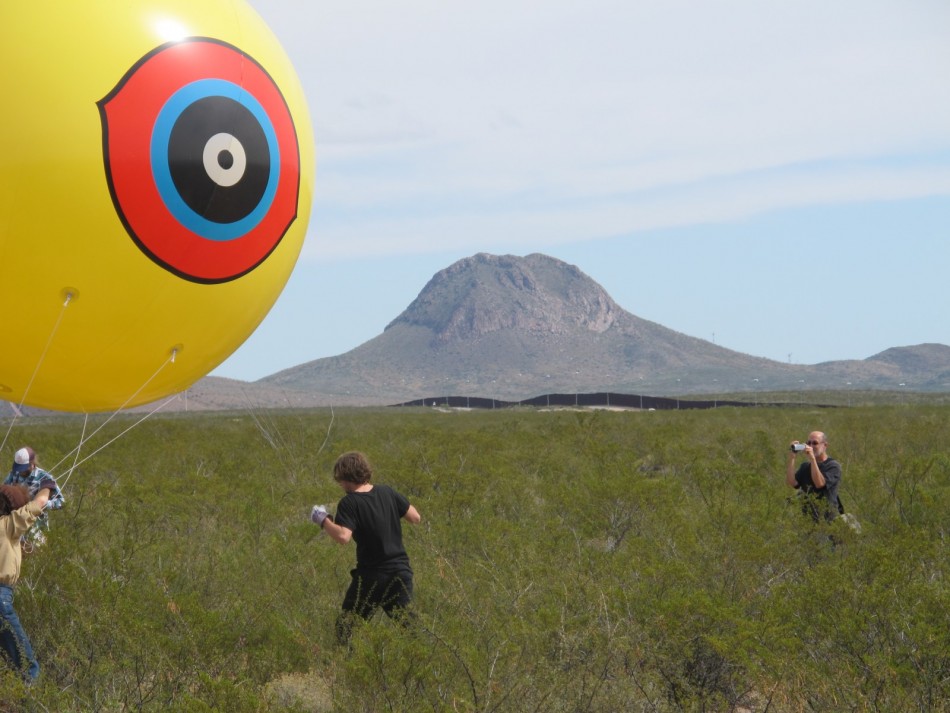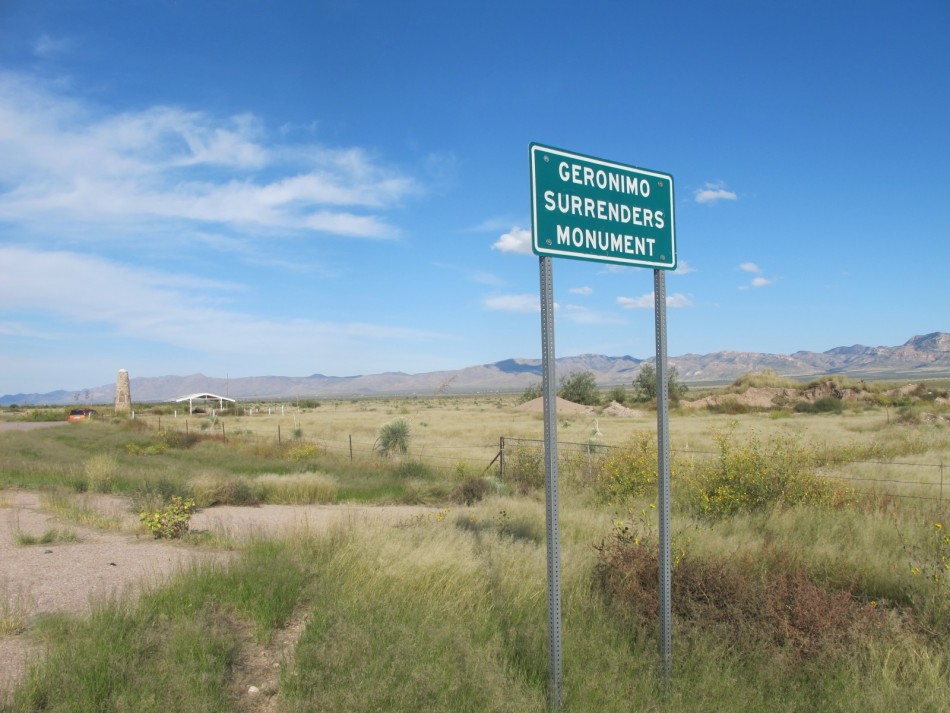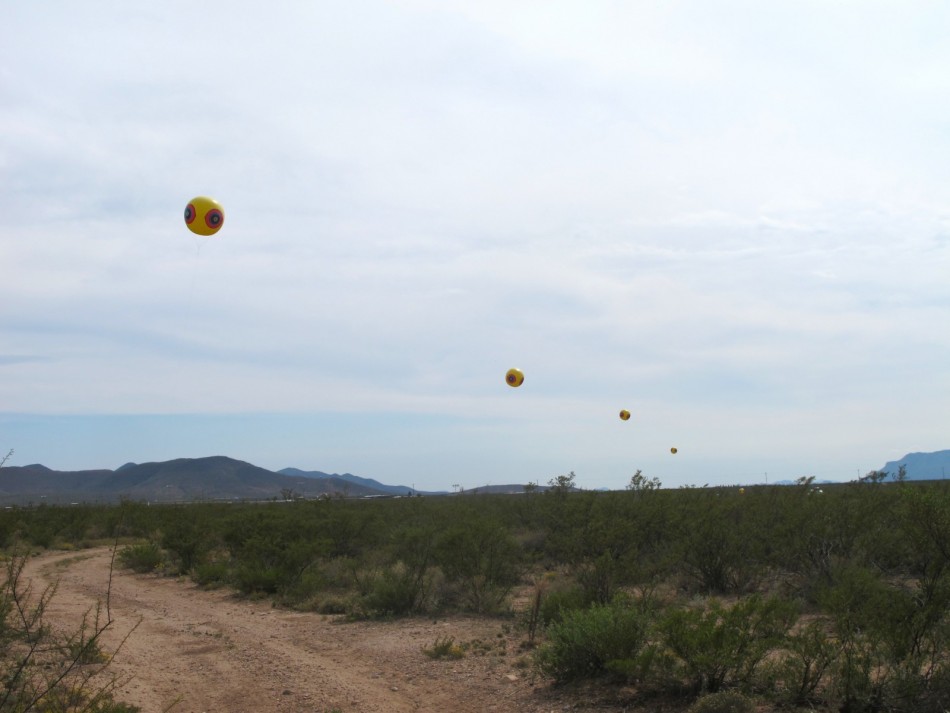
Setting up "Repellent Fence" with the U.S.-Mexico border fence in the background. (All photos by author.)
Postcommodity Threads Indigeneity into Border Narrative
The U.S. Border Patrol presence in and around Douglas, Arizona, is so ubiquitous that it’s banal. Even an hour outside of town, I counted at least four patrol vehicles on the highway. One sat poised on the side of the road, while the other three made short work of the drive, racing past us. The only other person we saw on that final stretch of highway was a hitchhiker parked under a shade structure at the “Geronimo Surrenders” monument.
For three days in early October, my family ventured down to Douglas for the launch of “Repellent Fence,” a 2-mile-long temporary art installation that would reach from Douglas to Agua Prieta, Sonora. The art collective Postcommodity — currently made up of Raven Chacon, Cristóbal Martínez and Kade Twist — envisions “Repellent Fence” as an intervention that specifically recalls indigenous North Americans split by the border by visually connecting, or “suturing,” the land on both sides. The Yaqui, for instance, have been dispersed across Sonora and the Southwestern U.S. after a century of warfare with the Mexican Government, and the Tohono O’odham Nation, a couple hundred miles west of Douglas/Agua Prieta, actually runs through or under the border depending on whether one views the materiality that particular social-political space as determined by the land or the fence.
Until the mid 1980s, Douglas was a booming copper town that depended on a flexible border for steady streams of labor and materials, which also led to Agua Prieta expansion. After Phelps Dodge Copper Company pulled out of the area, however, the “burden of employment” fell on state and federal governments and the drug trade, according to Mary Pat Brady in Extinct Lands, Temporal Geographies. The border tightened up, and the train depot that once connected the two cities sat empty for more than 15 years. In 1996, the city converted it into a police station, using prison labor. The shift, Brady writes, signals the “growing importance of policing to an increasingly globalized economy.” If Sonoran labor has been excluded from the U.S. economy, however, Sonoran capital has not. Within walking distance of the border crossing, the Douglas Walmart gives the impression that it was built for the convenience of affluent Sonorans, and the parking lot full of Sonoran license plates seems to confirm it.
Agua Prieta and Douglas enjoy a cooperative relationship. They operate under a “memorandum of understanding” that encourages cultural exchanges, such as sister fiestas and the cross-border art walk that took place over the weekend. Postcommodity considered building their fence there on the suggestion of friends who live in the area, but they decided to stay when officials from both cities immediately welcomed the project. The institutional and municipal coordination that resulted went much noted at the opening reception, Friday night, in the lobby of the historic Gadsden Hotel.
After losing a day and a half to high winds, the installation finally went up on Saturday afternoon, and it would last through the first Indigenous Peoples Day in Albuquerque. I rode out in the pickup truck with the crew to fasten the balloons to their anchors on that first day, elated to see the Sonoran equivalent ascend, as if acting out a call-and-response with ours. Only the rusty border fence and the Border Patrol SUV stood between us, and “Repellent Fence” clearly ran “over” them, a series of yellow, 10-foot diameter balloons that hovered 50 feet above the desert floor, 13 on each side of the border. Each balloon, moreover, had been inscribed with a pair of concentric circles in red, blue, black and gray — forming a set of “scare eyes,” which Postcommodity appropriated from a 10-inch consumer bird repellent product meant to scare away birds from gardens or landings.
For a moment, the continuity of the aesthetic repetition did seem make the landscape appear whole; or, rather, by undermining the border’s spatiality, the installation seemed to emphasize the border as a socially produced space. In the next moment, however, the “otherness” of the Sonoran landscape and the realness of the fence came into view when I wondered if I would I have enough time to get to the other side — properly, at the border crossing — before I had to head back to Albuquerque.
If the installation did, like Walmart and bi-national cooperation, reveal the border to be something of an artificially imposed barrier between cultures, what remained more difficult to see was how it functioned as an Indigenous intervention. Postcommodity had wanted to erect “Repellent Fence” along the Tohono O’odham stretch of the border, but tribal leadership didn’t want the attention, Chacon said; more specifically, they didn’t want to risk the possibility that smugglers would exploit the occasion.
That seems to leave the scare eyes, which, Chacon said, Postcommodity (re)appropriated from appropriated Indigenous iconography. But, according to Twist, the networks that reached across the border to make the installation possible performed acts of self-determination in the face of bureaucratic restrictions. Both the U.S. and the Mexican governments told Postcommodity that they would not be able to transport helium across the border. But using networks such as the Frontera de Cristo border ministry, they did so — and legally.
The suturing that the installation proposes, then, is an act of geographic and historic recovery that has implications in the present. It’s a reminder that before the Spanish and then the Americans colonized the region, Apache and Yaqui moved freely across the land. More importantly, by threading Indigenous iconography through the boundary, “Repellent Fence” actually makes legible the absence of Indigenous people in current border narratives.
For Twist, all “brown people” in the Western hemisphere are Indigenous, or descended from Indigenous people. National or even tribal affiliations, he says, were created by colonial powers to support colonial interests. Indeed, Scott Richard Lyons, in his book X-Marks: Native Signatures of Assent, argues that colonial governments created tribes in order to legitimate treaties through geographic and social boundaries.
Before we jumped back into the flatbed, I stood back from the balloon to take some photos and spotted a child’s glove and a toothbrush in the coarse sand. The wind, silent, held all of the balloons in a steady lean to the north, and the stillness of the scene seemed to disrupt the violent and sentimental bordertown narratives that the forgotten items might evoke on billboards or in commercials. Rather, “Repellent Fence” both superseded and incorporated the narrative of the harrowing border flight into its geopolitical purpose. The “Geronimo Surrenders” monument, commissioned by the City of Douglas, is actually one signpost of this broader narrative. The others included the train depot and the Walmart, as well as the Cochise County seal on G Street downtown that hangs just under the city’s logo.
Like the Geronimo Surrenders monument, the county seal stakes a claim to what was once Apache land, but in a significantly different way. It depicts a bright-red, disembodied head with long hair tied down by a headband, likely Cochise himself. Whereas Geronimo Surrenders is a demonstration of pure military strength, the seal, while derogatory, claims Cochise as one of its forefathers. His image, in other words, legitimizes conquest. The seal of Douglas, meanwhile, depicts an American flag and a Mexican flag, paired together at the top, with an adaptation of the Arizona state flag at the bottom. While the flag duplicates the colors of the flag of Spain and the 13 rays of the sun recall the original U.S. states, the city’s Indigenous presence yet remains unrecognized.
These symbols, as well as the absences in them, emphasize the temporal nature of the balloons by demonstrating that the past and its multi-valences are forever layered on the present and situated within the institutions that celebrate diversity and cooperation. As an intervention, then, “Repellent Fence” argues that cross-border cooperation is possible, even already in effect, and that transnational identities claimed by residents of both cities have been constructed and subsequently partitioned by colonialism. Yet, it leaves unresolved the question of how to address colonial structures without using colonial tools.

The Geronimo Surrenders monument

The train depot-cum-police station.

Seals of the City of Douglas and County Cochise

Repellent Fency flying
